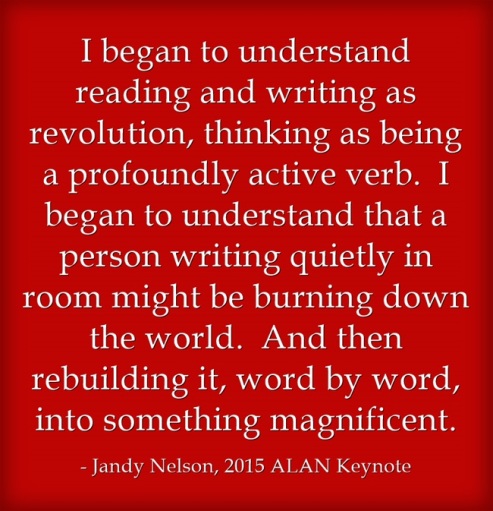Teachers, I’m stuck in a dilemma: How do you respond when members of your reading and writing community read and write when they’re not supposed to?
Those who sneak a book and read through a mini-lesson.
Those who slip a pencil in their hands to continue writing during whole class share.
My initial reaction is to monitor for compliance. If I tell you to stop reading, you should stop reading. If I can’t get you to stop reading, then you might do all sorts of other disruptive things, like, I don’t know.
My second reaction is that it’s impolite to broader community. Attempting to sneak a book during a mini-lesson is not polite to me or to those around you. Writing while somebody else is reading to you? Your body language says “I am more important than you right now.”
But there’s a another lesson to consider here: reading and writing happens on its own schedule, and sometimes we get so far into what Nancy Atwell calls the Reading Zone that we don’t want to leave. We won’t allow ourselves to leave.
I know firsthand what the reading and writing zone feels like, especially as an introvert who needs time and solitude (not necessarily silence, just solitude) to read, write, and think.
And as educators and observers, we can appreciate that students who read and write even when they are not expected to are in the midst of lifelong lessons about reading and writing. We’ve won over these teens for the big victory, the way I see it: their writing and reading is of importance to them beyond a grade, beyond what we think, and beyond what their peers think. No teacher would ever complain that students were making up math problems to solve that weren’t assigned for homework. No teacher would complain that students were fantasizing about science experiments they’d like to perform some day.
These students are engaged in a revolution of one:

Rather than attempt to interrupt thinking in progress Because I Said So or Because It’s Polite, here are some of the questions I’m considering before I ask students to stop, look, and listen:
- Is the stealthy reading and writing intended to disrupt or undermine other student learning?
- Is the stealthy reading and writing coming from a student who never or rarely engages in enthusiastic reading and writing?
- When will I have an opportunity to measure student progress and understanding of a teaching point?
I adjust some classroom routines to accommodate this stealth, too:
- Daily sharing is optional; students can share with a writing partner or friend in small groups and move around the room to share or they may sit at their desks and continue working for more stealth time.
- I don’t reprimand students for writing during independent reading blocks, but I also don’t expressly encourage it.
- I respect that not all students will be enthusiastic about sharing their work with me, especially if their writing and reading feels private and part of a deeply personal journey.
But … but… there’s always that careful balance between the needs of the community and the needs of the individual, so I’m interested in hearing from you about how you manage this stealth in your classroom.
Amy Estersohn is an English teacher in New York. She can be found blogging at Teaching Transition, No Flying No Tights, and other education and book review blogs. Amy was a 2016 recipient of the NCTE/ALAN Gallo Grant and a panelist for the CYBILS awards.


Very timely post for me. I teach reading support classes for middle school students who are well below grade level, and I had three boys today beg to be allowed to keep reading. The next activity was actually brainstorming class expectations and norms, so I asked them to think of .a way we could honor people’s desires to keep reading when they’re in the zone while still keeping everyone engaged in the other work as well. We didn’t have enough time to fully discuss it, but their initial responses were to either guarantee a half hour of reading time daily, or to have a “reading is always acceptable” attitude–as long as they are truly reading, they can prioritize that over anything else. It is really hard for me to tell a student who hasn’t had a great connection with books to “stop reading,” and to convince myself that any mini-lesson is going to give them more than they’re getting out of the experience of really reading. I have some more thinking to do for sure!
LikeLike
I’ve had this struggle with some of my kids, too, especially with reading. I usually tell them (when the timer goes off) that they need to get to a stopping place. Ideally that would be with all of us, but if they need to finish the line or the paragraph or even the page, that’s ok. It’s my expectation that they’ll be with us within 2-3 minutes. And I try to make sure that I structure my stuff so that there is an easing in period as people are coming together. We talk about it a lot at the beginning and I haven’t had huge problems. Every now and then someone reads the whole time we’re doing something else, but I handle that on a case by case basis. If it happens more than once in a row, then we have a conversation about priorities and the fact that it’s rude, etc. Like I said, it has worked fairly well. I’m fairly laid back, though, and I can tolerate some things that are a no go for others.
LikeLike
This is an impressive reflection, Amy. I end up in the same place as you, but I’ll admit I didn’t get there through such a thoughtful process. Thanks for modeling that.
LikeLike